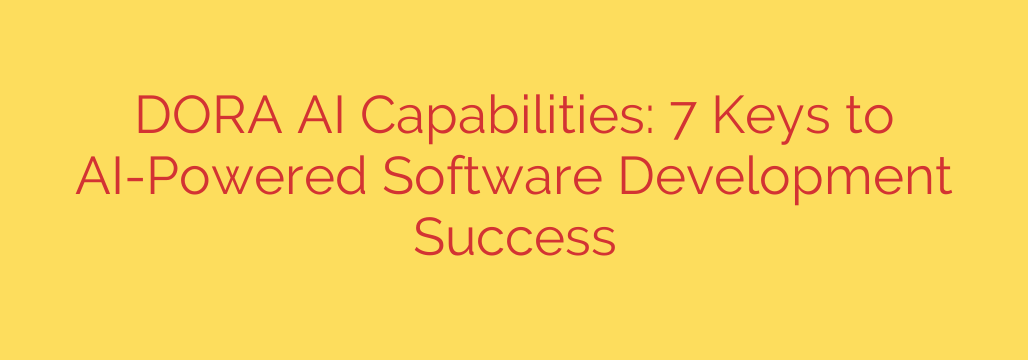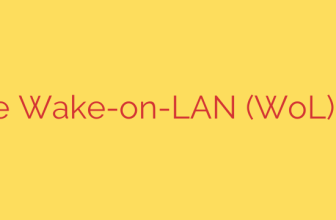
Unlocking Elite Performance: 7 Ways AI is Revolutionizing DevOps and DORA Metrics
In today’s fast-paced digital landscape, the pressure on software development teams has never been greater. The goal is clear: deliver high-quality software faster and more reliably than the competition. For years, the gold standard for measuring elite performance has been the DORA (DevOps Research and Assessment) metrics. These four key indicators tell the story of a team’s efficiency and stability:
- Deployment Frequency: How often an organization successfully releases to production.
- Lead Time for Changes: The amount of time it takes to get committed code into production.
- Change Failure Rate: The percentage of deployments causing a failure in production.
- Time to Restore Service: How long it takes to recover from a failure in production.
Achieving elite status in these metrics requires a finely tuned machine of processes and technology. Now, Artificial Intelligence (AI) is emerging as the ultimate catalyst, supercharging every aspect of the software development lifecycle. By integrating AI, teams can move beyond incremental improvements and make giant leaps in performance.
Here are seven key ways AI is fundamentally changing the game and helping teams master their DORA metrics.
1. Accelerate Development with AI-Powered Code Generation
AI coding assistants are no longer a novelty; they are a powerful force multiplier for developers. These tools can suggest code snippets, complete entire functions, and even help debug complex problems. By handling repetitive and boilerplate code, they free up developers to focus on high-value architectural and logical challenges.
This directly impacts DORA metrics by dramatically reducing Lead Time for Changes. With faster coding cycles, features move from concept to commit more quickly, accelerating the entire delivery pipeline.
Actionable Tip: Implement rigorous code reviews and automated testing for all AI-generated code. While these tools boost productivity, human oversight remains essential to ensure code quality, security, and adherence to best practices.
2. Achieve Higher Quality with Intelligent Test Automation
Traditional test automation requires significant manual effort to write and maintain scripts. AI is revolutionizing this process. AI-driven tools can automatically generate test cases by analyzing code changes, predict which tests are most likely to fail (“flaky” tests), and optimize test suites to run only the most relevant checks for a given change.
This intelligent approach directly lowers the Change Failure Rate. By catching more bugs with greater efficiency before they reach production, teams can deploy with higher confidence. It also shortens the testing cycle, contributing to a better Lead Time.
3. Proactively Ensure Stability with AI-Driven Anomaly Detection
Waiting for a system to fail is a reactive stance. AI allows teams to be proactive. By constantly analyzing logs, metrics, and traces from production systems, AI algorithms can identify subtle deviations from normal patterns that often precede a major incident. This could be a gradual memory leak, an unusual spike in API errors, or abnormal network traffic.
This capability is a game-changer for Time to Restore Service. In many cases, AI can alert engineers to a problem before users are impacted, allowing them to fix it before it becomes a full-blown outage.
Security Focus: AI-powered anomaly detection is a cornerstone of modern security operations. It can identify potential security breaches, such as unusual data access patterns or brute-force attempts, far faster than a human analyst.
4. De-Risk Deployments with Predictive Release Management
Is a new release safe to deploy? In the past, this question was answered with experience and gut feeling. AI brings data science to the forefront. By analyzing historical data from past releases—including code complexity, the number of changes, and previous incident reports—AI models can predict the risk level of an upcoming deployment.
This directly helps teams manage and reduce their Change Failure Rate. If a release is flagged as high-risk, teams can take preemptive action, such as conducting more thorough testing or planning for a phased rollout.
5. Slash Downtime with Automated Root Cause Analysis (RCA)
When an incident occurs, the race is on to find the root cause. Manually sifting through mountains of logs and dashboards is time-consuming and stressful. AI can automate this entire process. It can correlate events across different systems, identify the exact code change or infrastructure event that triggered the failure, and present a clear diagnosis.
This has a massive positive impact on Time to Restore Service (MTTR). By reducing the time spent on diagnosis, teams can move directly to remediation, restoring service for users in a fraction of the time.
6. Build Security In with AI-Enhanced DevSecOps
“Shifting left” means building security into the development process from the very beginning. AI is a powerful ally in this effort. AI-enhanced security tools can scan code as it’s being written, identifying complex vulnerabilities that traditional static analysis might miss. They understand the context of the code, leading to fewer false positives and more actionable security alerts.
This practice reduces the Change Failure Rate by preventing security vulnerabilities from ever becoming production incidents. A secure deployment is a stable deployment.
Actionable Tip: Integrate AI security scanners directly into your CI/CD pipeline. This ensures that every code commit is automatically checked, making security a seamless, non-negotiable part of your workflow.
7. Optimize Team Performance with Workflow Intelligence
How efficiently is your team actually working? AI can answer this question by analyzing data from project management tools (like Jira), code repositories (like Git), and communication platforms (like Slack). It can identify bottlenecks in the development process, highlight areas where collaboration is breaking down, and suggest process improvements.
While this doesn’t map to a single DORA metric, it improves the underlying system that drives them all. By removing friction and optimizing workflows, teams can naturally improve Deployment Frequency and Lead Time for Changes. This holistic improvement elevates the entire team’s performance.
The Future is Augmented Intelligence
The integration of AI into software development is not about replacing engineers. It’s about augmenting their skills, automating tedious tasks, and providing data-driven insights that were previously impossible to obtain. By embracing these AI capabilities, development teams can break through performance plateaus and achieve the elite levels of speed, stability, and security that define success in the modern era.
Source: https://cloud.google.com/blog/products/ai-machine-learning/introducing-doras-inaugural-ai-capabilities-model/








